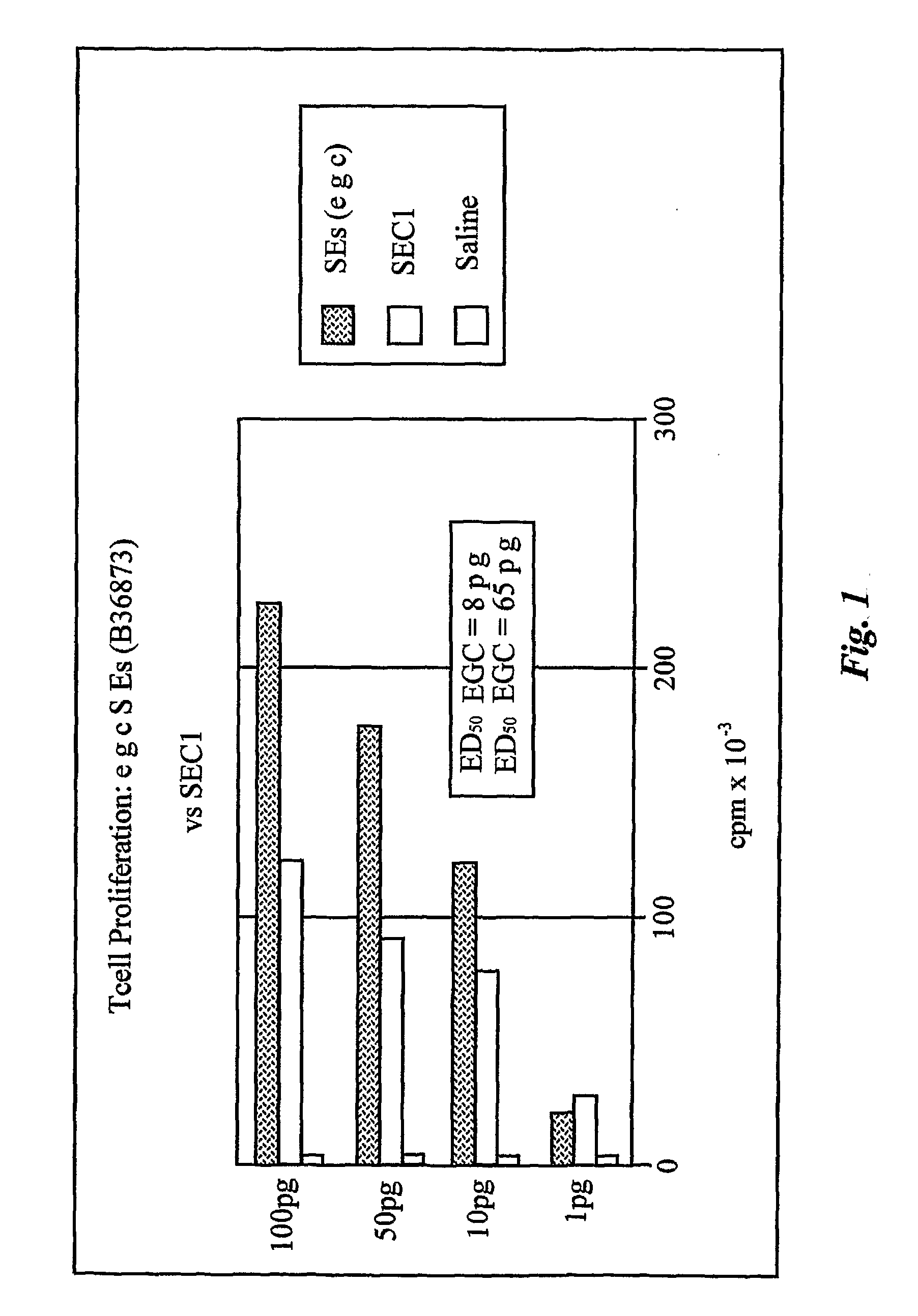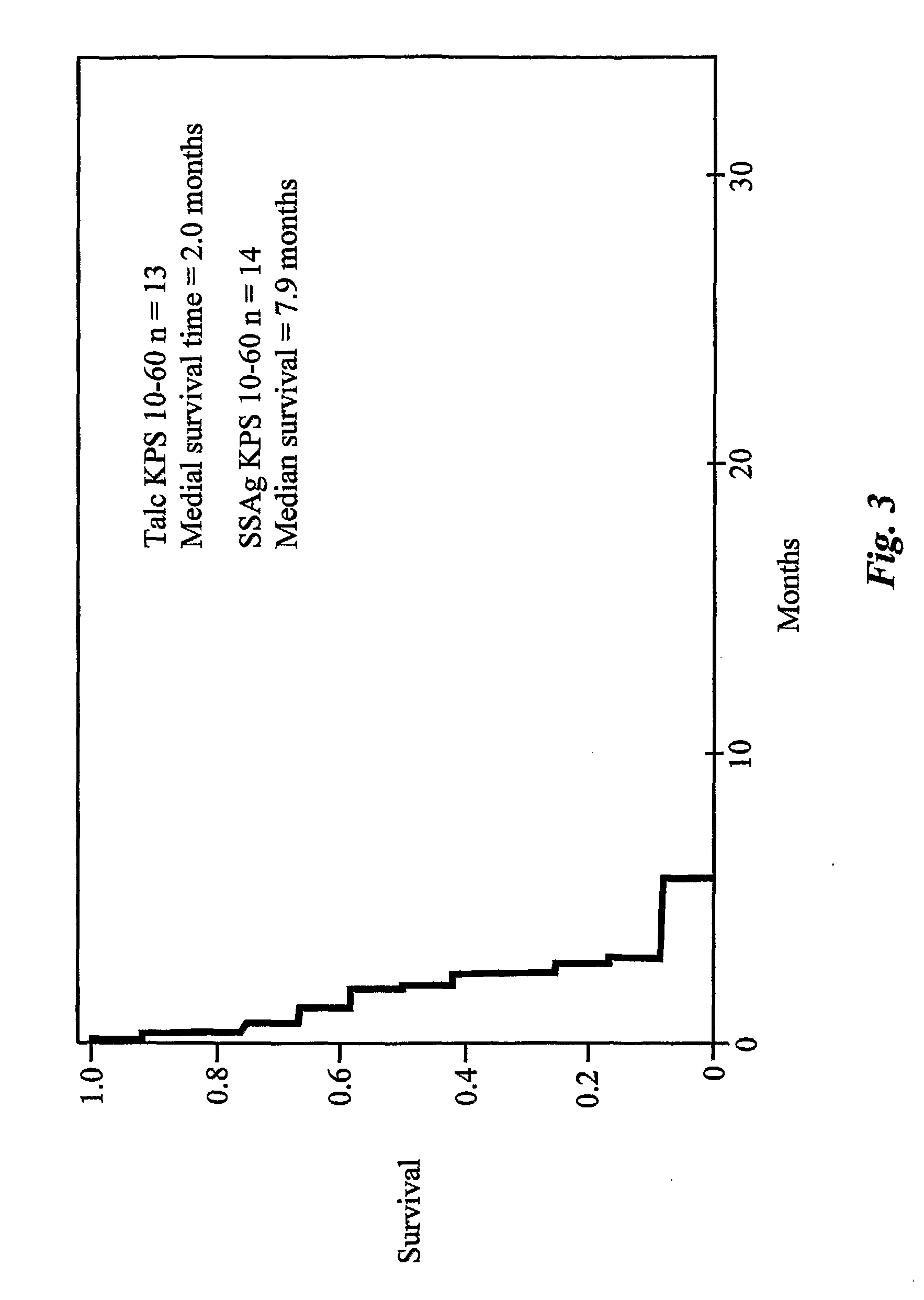Enterotoxin gene cluster (egc) superantigens to treat malignant disease
a gene cluster and egc technology, applied in the field of immunology and medicine, can solve the problems of limited effectiveness and significant toxicity, the use of agents with only modest success, and the prior art does not disclose the use of native egc ses as a plurality, so as to avoid toxic effects and morbidity, enhance the effect of chemotherapy and radiation on tumors, and prevent activation-driven death
- Summary
- Abstract
- Description
- Claims
- Application Information
AI Technical Summary
Benefits of technology
Problems solved by technology
Method used
Image
Examples
example 1
Detection and Identification of egc Staphylococcal Enterotoxins
Lymphocyte Proliferation Assay
[0350]Several Samples of the agent B36873 were assayed for their ability to induce proliferation of human T lymphocytes by standard 4-day mitogenicity assay (Poindexter N J, Schlievert P M et. al., J. Infect. Dis. 151:65-72 (1985). Human peripheral blood mononuclear cells (PMBCs) were isolated from heparinized blood of healthy human donors by fractionated by centrifugation through a Ficoll-Hypaque™ PLUS gradient (Amersham Biosciences, Uppsalla Sweden). Lymphocytes were washed and suspended to a concentration of 1.0×106 cells / ml in RPMI 1640 medium (Gibco / Invitrogen Corporation, Grand Island, N.Y.) containing 2% fetal bovine serum, 2 mM glutamine, 200 U sodium penicillin G per ml, and 200 μg of streptomycin sulfate per ml. Suspended cells were distributed into 96-well plates, 200 μl per well, then sample, 50 μl per well, was added. Plates were incubated at 37° C., 6% CO2, for 72 hours before ...
example 2
Intrathecal (Intrapleural) Injection of egc SAgs in Patients with Malignant Pleural Effusions
SAg-Treated Patients
[0369]From February 1999 to October 2002, 14 consecutive and unselected patients with NSCLC and MPE were treated with egc SAg. Patients were required to have non-small cell lung cancer (NSCLC) with, at least, 350 cc of pleural fluid. Systemic chemotherapy and all other biological-response modifying agents with antitumor activities were discontinued, at least one month prior to initiating treatment. Radiotherapy was allowed provided it was not focused on the site of the pleural effusion. Pleural effusions were confirmed by chest radiograph, chest CT and ultrasonography. The diagnosis of MPE was established by positive pleural fluid cytology in all patients. Karnofsky performance scores (KPS) before and after treatment were recorded for all cases. Irrespective of KPS, all patients satisfying the above criteria were eligible for this study.
[0370]Before each course of treatme...
example 3
Treatment of Lung Adenocarcinoma by Intratumoral Injection of SAgs Followed by Intratumoral Chemotherapy
Patient and Treatment Plan
[0398]The patient is a 75 year old man with a large adenocarcinoma in the left midlung field. He received intratumoral administration of egc SAgs (0.1 pg-1.5 ng) containing once weekly for 7 weeks.
[0399]During weeks 8-11, the patient received weekly intratumoral injections of egc SAgs together with cisplatinum (10 mg) intravenously. Chest x-rays were done before treatment and 1 week after the conclusion of the last dose of intratumoral SAg / Cisplatinum.
[0400]Criteria for response are as set forth by the International Union Against Cancer and are given in more detail below. Briefly, a complete response is defined as no measurable disease. A partial response is as a 50% reduction of the bidirectional diameter of measurable tumor.
Results: One week after concluding the course of intratumoral egc SEs followed by intratumoral egc SEs+cisplatinum, the patient's c...
PUM
| Property | Measurement | Unit |
|---|---|---|
| time | aaaaa | aaaaa |
| size | aaaaa | aaaaa |
Abstract
Description
Claims
Application Information
 Login to View More
Login to View More - R&D
- Intellectual Property
- Life Sciences
- Materials
- Tech Scout
- Unparalleled Data Quality
- Higher Quality Content
- 60% Fewer Hallucinations
Browse by: Latest US Patents, China's latest patents, Technical Efficacy Thesaurus, Application Domain, Technology Topic, Popular Technical Reports.
© 2025 PatSnap. All rights reserved.Legal|Privacy policy|Modern Slavery Act Transparency Statement|Sitemap|About US| Contact US: help@patsnap.com



